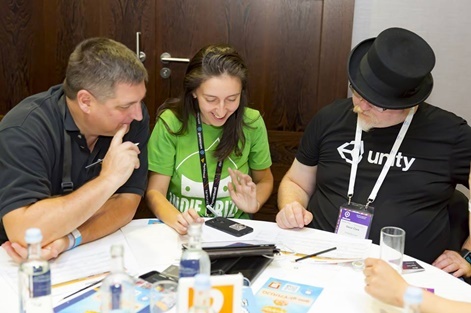Oscar Clark is co-founder at Rocket Lolly Games and Fundamentally Games.
The biggest curse of a game developer is that we too often fall in love with our own projects; or worse yet fall out of love with them when the realities of development start to force us to make compromises.
Investors often face the opposite problem. They can too easily lose track of what’s happening in their games projects; especially when development gets into complex levels of detail or when the game goes into testing or soft launch.
Precisely the time when the development team themselves are tied up with the minutiae of solving pressing problems they can lose the perspective to communicate effectively to their stakeholders.
When we are so close to the coal-face, working to deliver a project on time and to budget, we stop being able to see the bigger picture.
This means we lose sight of the target audience and that can damage our investor’s confidence in the project as well as our own chances of success.
Fresh perspective
When I’m not working on Rocky Horror:Touch Me or representing Unity I am often approached to help provide a fresh set of eyes for other people’s projects and although the specific issues vary it usually comes down to the same problem: the need for a wider perspective.
It seems that there are a set of common categories of question which keep coming up and lessons where developers and investors can benefit from having this kind of external point of view.
When we are so close to the coal-face, we stop being able to see the bigger picture.
The first category often comes from either teams that are struggling to find investors or investors who need more confidence for the market potential of a project they are looking to invest in. They usually need a flexible business model with the ability to show different scenarios based on changing assumptions.
Most developers aren’t trained in market analysis and the idea of building a business model can seem like rocket science; whilst often investors don’t know how the games market works in sufficient detail.
Either way the principles are fairly straightforward. It starts with finding comparable data showing the success levels of similar games and genres
There are tools such as Apptoppia, AppAnnie, SteamSpy, etc which can provide you with a baseline – but unlike the old physical retail era there is no universal sharing of accurate data so many of these models rely of assumptions build on top of the data provided by the platform holders like Apple, Google and Steam.
That is great for core elements such as daily active users and retention, but you basically have no idea of how much of that success was driven by game design, direct response advertising, influencer marketing or social media. We also largely have no idea how games revenue was divided up between ads and IAP.
So we have to make assumptions based on what information is revealed at games events and in trade press. Anyone can do that work given practice. But having confidence in that model often requires external validation.
The perfect fit
The second category is looking at market fit for the game. This is a lot harder to assess and the only effective way to check market fit is to put a game live on an app store.
Teams like Gram Games do this themselves with an amazing approach where they prototype a mechanic then release that to the market cold. No marketing. If the game gets any users and shows promise then they will develop it further.
One of the benefits of events like the Big Indie Pitch is that you get the feedback from over a dozen industry experts all in one place.
That is brilliant for simple mechanic focused games; but is more problematic if you are trying to build a more complex game like a card battler or rhythm action game, where the slightest issue of the UX can disguise a superb gameplay idea. In these cases having the oversight of an experience designer who isn’t invested in the project can be invaluable.
They do however, need to have both a broad understanding of the market as it stands and enough specific knowledge of the genre (and indeed sub-genre of game) to be able to provide useful feedback. That can be hard to find. It’s also important to be very careful how you use that insight.
Any designer will bring their own vision to a review and that won’t necessarily be aligned to your plans; so you have to take any advice with a heavy pinch of salt. They will provide advice which is for the game they want to make – not what you are making!
However, it can be highly useful if you treat the process as a sanity check or sounding board and remember that whilst you benefit by openly listening; you have no obligation to implement any of their ideas.
One of the benefits of events like PocketGamer’s Big Indie Pitch is that you get the feedback from over a dozen industry experts all in one place but it can a painful process when your “darling” doesn’t get selected by the judges.
Bridge the gap
Category three is a question of production and too often a consultant like me only gets involved when there is a break-down of trust between the investor and developer or a failure to meet milestones.
Sometimes this comes from a change is specification, other times a misjudgement in the scoping stage but usually this comes from a problem where the logic of a design falls apart when implemented.

From an investor point of view this is hard to understand because surely the design was proposed because it would deliver a gameplay experience. However, finding the fun is not that straightforward and requires iteration.
As with all things the first stage is to rebuild trust and that’s where a third-party can come in and reconcile to two parties; but that means they have to be able to understand the problem and be able to make recommendations.
Sometimes, regrettably, that recommendation is to end the project. Fortunately, most of the time it’s in the interest of both parties to find a solution but again it’s important to have an external perspective to help select solutions which match the market requirements not just deliver to the milestones.
We've found that key to building confidence for both the stakeholders and the developer is to have clarity in the milestones and expectations.
This can mean that the team needs mentoring to help get them back on track and the investors need someone to reassure them that this is business as usual; iteration seems scary but it is the best way to make sure we get the best games released.
We have found that key to building confidence for both the stakeholders and the developer is to have clarity in the milestones and expectations of what will be delivered at each stage.
To help with that we have developed a simple cloud-based tool called Wigwam which tracks each stage and each stakeholder; like a Docusign for Production. It’s really helping us to help our clients and we are looking to open this out for other developers as a beta program in November.
Early planning
The last category is where the game is getting ready for going to market. And again this is usually where developers and investors reach out to external support far too late.
Part of this is marketing and part of this is the transition to live operations. Marketing is an area which to many seems like a dark art; however again the principles are pretty straight forward. We look at product design, pricing strategy, place (platform where we are selling and the channels of communication) and promotion (the way we communicate).
All of this takes time and budget (or at least a person to act) and all of this benefits from starting early. Marketing games on mobile in particular, but also on Steam, requires a combination of social media, user acquisition spend and in-game design which leads to retention as well as social sharing.
However, that doesn’t mean that there is no role for traditional marketing and PR – just that they play different roles than simple installs.
For too many indie and mobile projects Executive Production has all but disappeared.
The real trick to marketing, if there is one, is to think about your audience, how you reach them and how you move them from unaware to aware and then interested; then how you develop their desire and trigger them to act – i.e. to install the app and have enough momentum to get through the tutorial and initial learning phase to become regular players.
Unlike marketing the transition to Live operations is an area where the difficulties are often underestimated. The point where your game hits an audience all your expectations will be confounded and you need to have the ability to respond to technical, consumer and social media incidents rapidly.
If you have planned correctly you will also have a pipeline of new content and features already lined up; but it is very easy for these plans to fall by the wayside due to the other commitments you encounter in development.
Most successful games have to be operated as services to sustain the level of interest and to have a chance at success and if this is not planned for in the beginning this can be difficult to retrofit.
If you look at all these situations these are all factors which would in traditional triple-A development be managed by the Executive Producer; but for too many indie and mobile projects that role has all but disappeared.
We founded Fundamentally Games to help provide a way to resolve that need for project-based Executive Production who can bridge the gap of expectation between the investor and the developer and help both sides understand realistically where they stand and be able to have confidence in their plans.
That’s something which always seems to require an outside perspective.






















